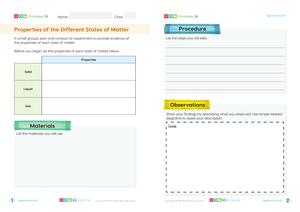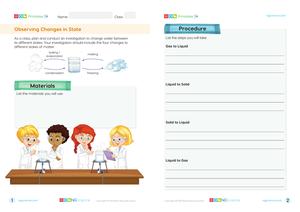Begin with a captivating demonstration: Show students a balloon filled with air and gently squeeze it to illustrate how gases change shape and volume. This visual hook will engage students and introduce the concept of states of matter.
Go to the LessonLearning Objectives
- Identify and describe the unique properties of solids, liquids, and gases.
- Explain how the arrangement and movement of particles differ in solids, liquids, and gases.
- Demonstrate understanding of how solids, liquids, and gases respond to changes in container shape and volume.
- Explore the concept of compressibility in gases compared to solids and liquids.
Introduction and Hook
Direct Instruction
Explain the properties of solids, liquids, and gases using real-life examples such as a desk (solid), water (liquid), and air (gas). Discuss how particle arrangement and movement differ in each state.
Guided Exploration
Conduct a class discussion on how solids, liquids, and gases respond to changes in container shape and volume. Encourage students to share their observations and experiences.
Hands-On Activity
Engage students in a hands-on activity where they classify objects around the classroom as solids, liquids, or gases. This activity reinforces the understanding of different states of matter.
Independent Practice
Assign students to explore their homes and list examples of solids, liquids, and gases they encounter. Encourage them to note the properties that define each state.
Check for Understanding
Conduct a quick quiz using the 'States of Matter – Comprehension' assessment to evaluate students' understanding of mass, volume, and particle arrangement in different states of matter.
Try the QuizReview and Reflection
Facilitate a class discussion to review key concepts learned about states of matter. Encourage students to share what they found most interesting or challenging.
Assessment and Extension
Use the 'Observing Changes in State' assessment to have students plan an investigation and describe their observations with diagrams. This worksheet assesses understanding through procedural steps and interpretive questions.
Encourage students to extend their learning by exploring the concept of compressibility in gases compared to solids and liquids through additional research or experiments.





